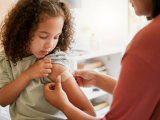Sep 6, 2011
Study inconclusive on role of H1N1 vaccine in neurologic events
Researchers who analyzed serious neurologic events that occurred in people who received the pandemic 2009 H1N1 vaccine concluded that 33% were "possibly" related to the vaccine, but none had a "probable" or "definite" link to it, according to a report published online by Vaccine. The study was conducted by a large team of researchers from the US Centers for Disease Control and Prevention (CDC) and several academic and healthcare institutions. They looked at all serious (but nonfatal) adverse events with neurologic presentations that followed H1N1 vaccinations given from October 2009 through March 2010, as reported to the Vaccine Adverse Event Reporting System. There were 212 such events. The investigators reviewed additional medical records and clinical information as available. The most common diagnoses were Guillain-Barre syndrome (GBS), 37.3% of cases; seizures, 10.8%; cranial neuropathy, 5.7%; and acute disseminated encephalomyelitis, 3.8%. The researchers classified 72 cases (33%) as possibly related to the vaccine, 108 (51%) as unlikely to be related, and 20 (9%) as unrelated. Twelve cases (6%) were not classifiable. The authors note that the absence of a specific test for indicating whether a vaccine component contributes to an adverse event makes assessing causality difficult. In June the CDC released a preliminary analysis showing that there were 0.8 excess cases of GBS per 1 million 2009 H1N1 vaccinations, about the same risk as with seasonal flu shots.
Sep 3 Vaccine report
Jun 2 CIDRAP News story on CDC report on GBS risk
Severely disabled show reduced immune response to H1N1 vaccine
Immune responses to pandemic 2009 H1N1 flu vaccine among residents in a long-term care facility who have severe motor and intellectual disability (SMID) were not strong enough to meet US and European general standards for flu vaccines, according to a Japanese study in Vaccine. Researchers assessed immune response after one dose of vaccine in 104 residents (mean age, 40.1) and 179 healthcare workers (HCWs; mean age, 40.7). The SMID residents had a seroprotection rate of 56.3% (95% confidence interval [CI], 46.2%-66.1%), seroconversion rate of 54.1% (95% CI, 43.7%-64.2%), and geometric mean titer ratio (GMTR) of 5.4 (95% CI, 4.9-5.9), below the criteria of both the European Medicines Agency (EMA) and US Food and Drug Administration (FDA). In contrast, the HCWs had a seroprotection rate of 79.9% (95% CI, 73.3%-85.5%), seroconversion rate of 77.9% (95% CI, 70.8%-84.0%), and GMTR of 7.3 (95% CI, 6.9-7.8), all exceeding EMA and FDA standards. The researchers write that a second dose of vaccine is unlikely to produce a protective immune response. They conclude, "Further study is required to determine if vaccination over consecutive influenza seasons can improve immunogenicity in subjects with SMID."
Sep 3 Vaccine abstract
AAP updates flu vaccine recommendations
The American Academy of Pediatrics (AAP) recently updated its flu vaccination recommendations for children, which emphasize the need to be vaccinated this year, even if children were immunized last year. Though the 2011-12 vaccine contains the same three strains as last year's flu vaccine, the AAP said immunity can drop as much as 50% in a year's time and that receiving another dose can help provide optimal protection. The guidelines appeared online Sep 1 in Pediatrics. AAP guidelines echo the CDC's universal flu vaccination recommendation that anyone 6 months and older be immunized, with special efforts aimed at the most vulnerable groups, including children younger than 5 years, kids with chronic health conditions, and pregnant women. The new guidelines note that most children with mild egg allergy can safety receive the vaccine and contain a simplified dosing algorithm for giving flu vaccine to children.
Sep 1 Pediatrics report
Three Vietnam provinces report H5N1 outbreaks
Vietnam's agriculture ministry yesterday reported three H5N1 avian influenza outbreaks that hit villages in three different provinces, according to a report to the World Organization for Animal Health (OIE). The events started between Aug 18 and Aug 26. One of the outbreaks struck a village in Thai Binh province, located in northern Vietnam's Red River delta area, killing 50 birds and leading to the culling of 158 more. The other two outbreaks hit villages in Quang Ngai and Quang Tri provinces, located in central Vietnam. The outbreak in Quang Ngai killed 690 birds, with 1,110 more destroyed to control the spread of the disease. The event in Quang Tri led to the death of 131 birds and the culling of 119 more. The outbreaks are the first since early August, when the virus struck five villages in Nghe An province.
Sep 5 OIE report


















